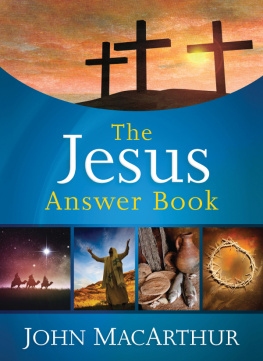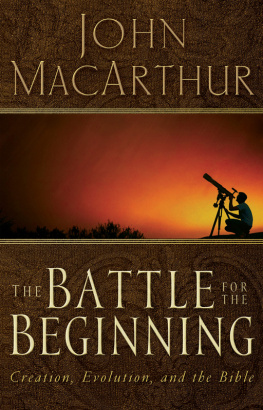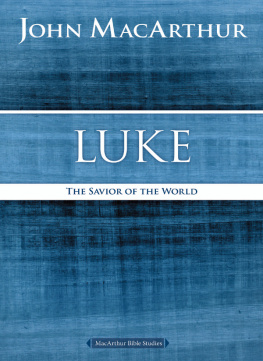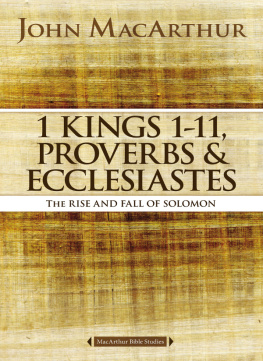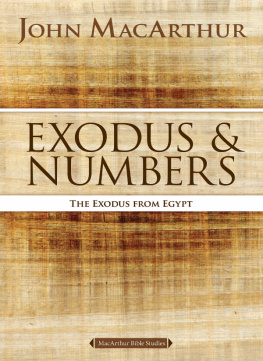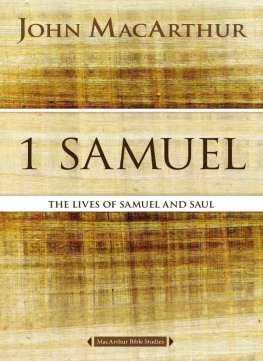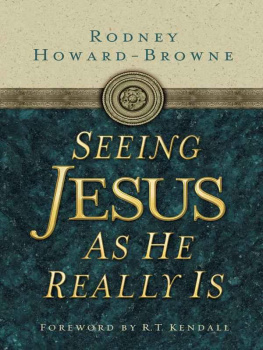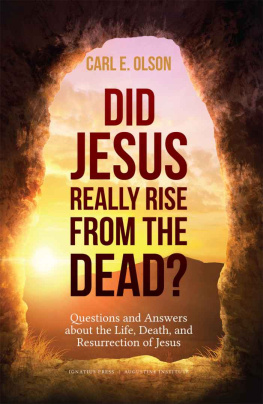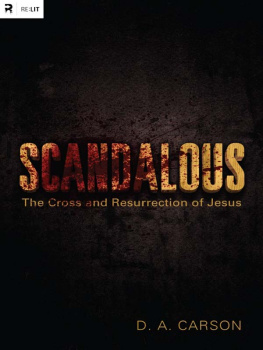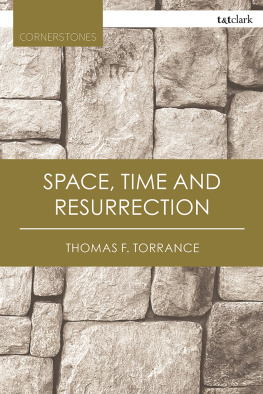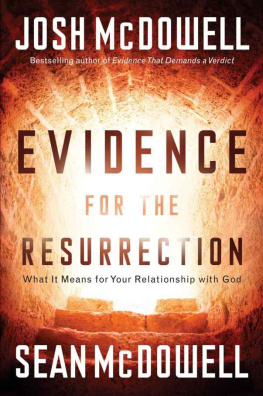
2014 John MacArthur
This text includes edited material from previously published works by John MacArthur and is used with his permission.
All rights reserved. No portion of this book may be reproduced, stored in a retrieval system, or transmitted in any form or by any meanselectronic, mechanical, photocopy, recording, scanning, or otherexcept for brief quotations in critical reviews or articles, without the prior written permission of the publisher.
Published in Nashville, Tennessee, by Thomas Nelson. Thomas Nelson is a registered trademark of HarperCollins Christian Publishing, Inc.
Italics in Scripture indicate the authors emphasis.
Unless otherwise noted, Scripture quotations are taken from THE NEW KING JAMES VERSION. 1982 by Thomas Nelson, Inc. Used by permission. All rights reserved. Scripture quotations marked NIV are from the Holy Bible: New International Version, NIV. 1973, 1978, 1984, 2011 by Biblica, Inc. Used by permission of Zondervan. All rights reserved worldwide. www.zondervan.com Scripture quotations marked NASB are from NEW AMERICAN STANDARD BIBLE. The Lockman Foundation 1960, 1962, 1963, 1968, 1971, 1972, 1973, 1975, 1977, 1995. Used by permission. Scripture quotations marked ESV are from THE ENGLISH STANDARD VERSION. 2001 by Crossway Bibles, a division of Good News Publishers.
ISBN-13: 978-1-4003-2270-1
Printed in China
14 15 16 17 18 LEO 6 5 4 3 2 1
Contents
T he Son of God stepped out of heaven and entered this world to dwell among us. His ultimate purpose is to rule and receive worship forever, but first He came to seek and to save the lost (Luke 19:10)to save His people from their sins (Matthew 1:21). Specifically, He came to die in order to offer His own life as a sacrifice for undeserving sinners. He came [not] to be served, but to serve, and to give His life a ransom for many (Matthew 20:28).
In order to do that, He entered this world as a helpless infant. He lived a sinless life of perfect obedience under the rigorous demands of Moses law (Galatians 4:4), while embodying all the perfections of divine holiness. Even though He was subject to normal human vulnerabilities such as hunger, thirst, and weariness (Hebrews 4:15), He triumphantly resisted every temptation that is common to us all (Hebrews 2:18). Setting aside His glory as sovereign Lord of all, He humbled Himself to become a slave for all, suffering the most disgraceful death on a crossexecuted as if He had been guilty of capital crimes (Philippians 2:611).
When it may have seemed His life and ministry had utterly failed, He gloriously rose from the dead, demonstrating His authority over life and death and His power over all the forces of hell.
Jesus died and rose for His chosen peoplethose who would believe in Him and confess Him as Lord. On that cross He bore their guilt and suffered the punishment due to them. Having thus atoned in full for their sins, He graciously covers them with His own perfect righteousness (2 Corinthians 5:21) so that they stand before God fully justified. He freely grants us eternal life.
That is the heart of the gospel message, the greatest story ever told. It culminates in the greatest and most gracious invitation ever given: Let him who thirsts come. Whoever desires, let him take the water of life freely (Revelation 22:17).
In Jesus Christ we see the fullness of the glory of God on display. The mystery and majesty of that glory shines brightly for those who have spiritual eyes to see. My prayer for you is that as you read, God will open your eyes to see, your mind to understand, and your heart to embrace the truth about the Lord Jesus Christ. Above all, I pray that you will love the living Savior Himself and receive His gift of eternal life.
For the Master,

T he eternal, sovereign God came to earth as a human being to live a righteous life among His people and then to die as a perfect sacrifice to deliver from the wrath of God all who repent and believe. With those truths in mind, we dare not trivialize or sentimentalize the persons and events surrounding the birth of Christ. The almighty God of the universe humbly came to earth in human flesh to seek and to save the lost (Matthew 18:11; Luke 19:10; 5:32; Romans 5:8).

M atthew needs only one verse (1:18) to announce the fact of Christs virgin birth. Such a concise statement, though it doesnt all by itself prove the point, strongly suggests that the notion of our Lord and Saviors virgin birth was not simply a man-made story. A human author, writing strictly on his own initiative, would characteristically tend to describe such a momentous and amazing event in an expansive, detailed, and elaborate manner. But not the apostle Matthew. He does relate additional circumstances surrounding the virgin birth, but the basic fact is stated in one simple sentence: After His mother Mary was betrothed to Joseph, before they came together, she was found with child of the Holy Spirit.
A dmittedly, all these many centuries after Matthews divinely inspired gospel declared that Jesus was born of a virgin, His miraculous conception remains impossible to understand by human reason alone. It was a miracle, and there is no natural explanation for it. We dont need a scientific or analytical explanation for it, any more than we need scientific proof of how the intricacies of the universe were created from nothing. Scripture is peppered with miracles and mysterious doctrines. How can God be one being in three persons? How could Christ rise from the dead? We cant even explain precisely what happens when depraved sinners are born again as they repent of their sins and trust Christ. Many of the essentials of Christianity are beyond the capacity of human minds to fathom. Thats okay. We cant comprehend infinity either, but no one doubts the concept. Scripture is full of truths that transcend human thoughts. For who has known the mind of the LORD? Or who has been His counselor? (Romans 11:34). God wants believers to accept the truth of His Word by faith.
I n Luke 1:34, Mary asked the angel, How can [I have a son], since I do not know a man? Marys question was born out of wonder, not doubt nor disbelief, so the angel did not rebuke her. Then, once she understood a little more clearly, Mary offered a song of praise, known as the Magnificat. Mary refered to God as Savior, indicating both that she recognized her own need of a Savior and that she knew the true God as her Savior. Mary did not see herself as sinless, nor did she trust in her own good works. Quite the opposite was true; she employed language typical of someone whose only hope for salvation was divine grace. The quality of Mary that shines most clearly through this passage is a deep sense of humility.
F rom their earliest days as a people, the Jews considered their ancestry important. They divided the promised land into tribal areas, and within those areas were towns and villages that belonged to certain families who owned land there. Every fifty years the various lands would revert to the original owners, so genealogies were very important.
In addition, these careful, detailed records of their family histories enabled each man to identify his fathers home area and go back there for official obligations such as Caesar Augustuss census.
The writers had two different goals. Lukes genealogy, aiming to show Christ as the redeemer of humanity, goes all the way back to Adam (Matthew 1:117; Luke 3:2328). Matthews purpose is somewhat narrower: to demonstrate that Christ is the King and Messiah of Israel. (Matthew quotes more than sixty times from Old Testament prophetic passages, emphasizing how Christ fulfills all those promises.)
Next page
